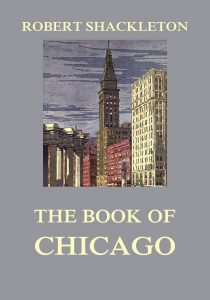The Book of Chicago – Robert Shackleton
In his facile, chatty way the author tells of the city’s marvelous growth, taking us from the Loop through that Olympus of Chicago, the Lake Shore Drive to Oak Park and South Chicago. The landmarks of the early settlers and the “beauty spots” of the modern city are all described in such a manner that they cannot fail to appeal to even the most conservative of Easterners. Mr. Shackleton in all his books of the cities, shows each one distinctly; its characteristics, institutions, literary traditions, landmarks, and its people. Nothing is too small for him to chronicle—their habits of speech, their eating, ancestor worship. In each city he manages to discover many odd corners not found by the usual sightseer. His is a sympathetic, clear-eyed, often humorous interpretation of the city in each case.
Format: Paperback.
The Book of Chicago
ISBN: 9783849684822
Available at amazon.com and other venues.
Chicago Basics (from Wikipedia):
Chicago is the third-most populous city in the United States. With over 2.7 million residents, it is also the most populous city in both the state of Illinois and the Midwestern United States. It is the county seat of Cook County. The Chicago metropolitan area, often referred to as Chicagoland, has nearly 10 million people and is the third-largest in the U.S. Chicago has been called a global architecture capital. In terms of wealth and economy, Chicago is considered one of the most important business centers in the world.
Chicago was incorporated as a city in 1837, near a portage between the Great Lakes and the Mississippi River watershed, and grew rapidly in the mid-nineteenth century. Positioned along Lake Michigan, the city is an international hub for finance, commerce, industry, technology, telecommunications, and transportation: O’Hare International Airport is the second-busiest airport in the world when measured by aircraft traffic; the region also has the largest number of U.S. highways and rail road freight. In 2012, Chicago was listed as an alpha global city by the Globalization and World Cities Research Network, and ranked seventh in the world in the 2016 Global Cities Index. Chicago has the third-largest gross metropolitan product in the United States—about $640 billion according to 2015 estimates. The city has one of the world’s largest and most diversified economies with no single industry employing more than 14% of the workforce.
In 2016, Chicago hosted over 54 million domestic and international visitors, a new record making it one of the top visited cities in the nation. Landmarks in the city include Millennium Park, Navy Pier, the Magnificent Mile, Art Institute of Chicago, Museum Campus, the Willis (Sears) Tower, Museum of Science and Industry, and Lincoln Park Zoo. Chicago’s culture includes the visual arts, novels, film, theater, especially improvisational comedy, and music, particularly jazz, blues, soul, hip hop, gospel and house music. There are many colleges and universities in the Chicago area; among these, Northwestern University, University of Chicago, and the University of Illinois at Chicago are classified as “highest research” doctoral universities. Chicago also has professional sports teams in each of the major professional leagues. The city has many nicknames, the best-known being the Windy City.
(The text of the last section was taken from a Wikipedia entry and is available under the Creative Commons Attribution-ShareAlike License.)
Publisher’s Note: This book is printed and distributed by Createspace a DBA of On-Demand Publishing LLC and is typically not available anywhere else than in stores owned and operated by Amazon or Createspace.

